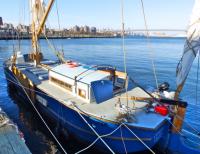
Photo: Will Van Dorp
The Vermont Sail Freight Project sailing barge Ceres called in New York harbor this weekend with a cargo of non-perishable produce from a total of thirty farms from Vermont and the state of New York. The had sailed the barge down Lake Champlain in Vermont, through the Champlain Canal and then down the Hudson, stopping at riverside towns along the way. She docked on Saturday at the Brooklyn Navy Yard for a market and a party. See Will Van Dorp’s post on the Tugster blog for great coverage of the Brooklyn events.
I caught up with them on Sunday at the New Amsterdam Market, a pop-up farmers’s market where the old Fulton Street fish market once operated. I got to meet Erik Andrus, the Vermont farmer who conceived the Sail Freight Project and raised the initial capital on Kickstarter to fund the construction of the barge last April. With several others, he was tending the very busy farm stand. He seemed pleased but admitted to being a exhausted, which is not surprising.
The Vermont Farm Sail Project has partnered with The Greenhorns, an Essex, N.Y.-based farmer advocacy group, and the Willowell Foundation, a nonprofit education organization to help with funding logistics and volunteers. The are also working with the on-line grocery service Good-Eggs, which allows customers to order produce in-advance on-line for pick up. We ordered an assortment of maple syrup, apple butter, pepper jelly, a variety of heirloom beans and some artisan soap in advance on line and picked it up at the New Amsterdam market. They also offered a range of rice, seeds and grains; honeys; pantry vegetables; roots, herbs and medicinals; oils and vinegars; as well as soaps and body lotions. Quite a range of enticing goods. The Ceres will soon be sailing home with a back haul of canning jars and coffee.
A few days ago the New York Times spoke with Severine von Tscharner Fleming, the founder of the Greenhorns, one of the project partners. They asked her “Is this a publicity stunt or a workable new paradigm for feeding the world?” Von Tscharner Fleming freely admits that it’s a bit of both. “Nine million people live within walking distance of the boat’s markets,” she said. “Frankly, it shouldn’t be a luxury to eat regional food. We’re allowing ourselves to imagine what it might mean to reshuffle the system and move toward a compelling, regionally appropriate, affordable, satisfying diet.”

Hi Rick Spilman,
Very interesting, very informative blog for all of us. thanks a lot!
Kindest Regards
alayela